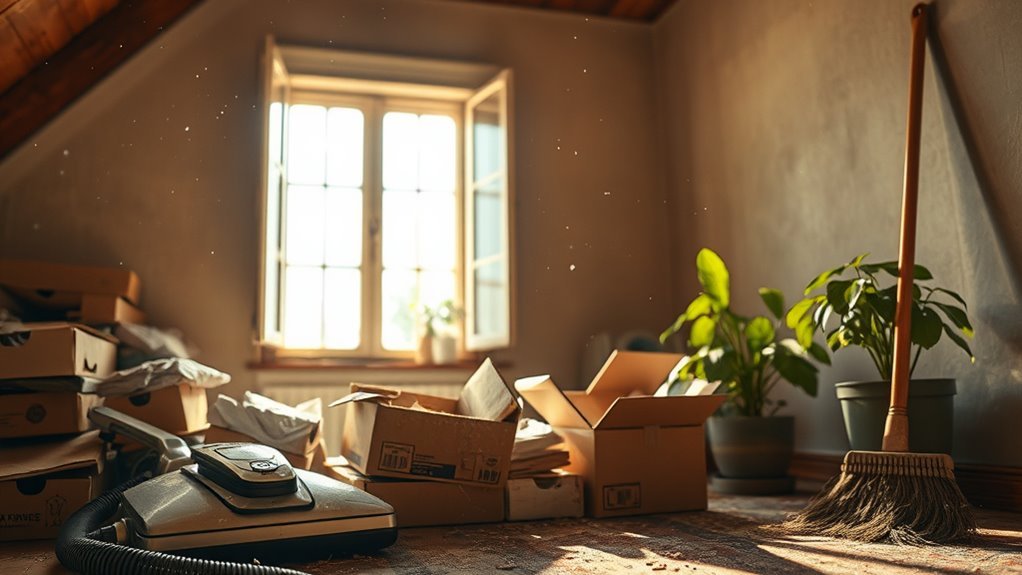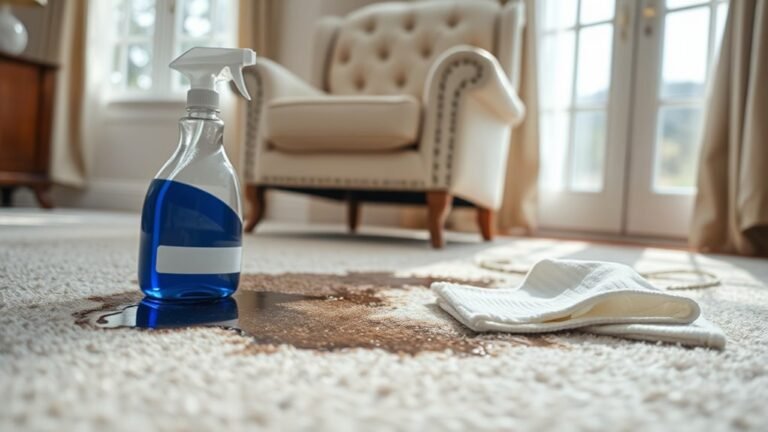How to Clean Your Home After Attic
After attic work, start by evaluating dust spread and gather microfiber cloths, HEPA vacuums, and protective gear. Open windows to ventilate your home, then carefully dust and vacuum floors, baseboards, and vents to capture hidden particles. Don’t forget to clean or replace air filters to improve air quality. Wash or vacuum fabrics thoroughly, and verify everything dries completely to prevent mold. Staying methodical with these steps helps restore clean air and surfaces—there’s more to contemplate for lasting freshness.
Assess the Extent of Dust and Debris

How much dust and debris has actually settled in your home after attic work? Begin by performing a thorough attic inspection to identify all areas where dust might have escaped into living spaces. Check vents, ceiling corners, and light fixtures closely. Dust identification is essential; categorize particles by size and type—fiberglass, insulation fragments, or general construction dust—to determine appropriate cleaning methods. Use a flashlight to spot fine dust settling on surfaces and test air quality if possible. This methodical assessment helps you understand the cleanup’s scope, ensuring you address every nook. Knowing exactly what you’re dealing with empowers you to reclaim your home’s freedom from lingering attic dust and debris effectively and efficiently, setting a clear path for the next cleaning steps.
Gather Essential Cleaning Supplies
Before you start cleaning, make sure you have the right tools like microfiber cloths, a vacuum with a HEPA filter, and sturdy brushes. Choose effective cleaning solutions that can tackle dust and any potential mold or stains. Don’t forget protective gear such as gloves, a mask, and goggles to keep yourself safe throughout the process.
Must-Have Cleaning Tools
Although cleaning your home after tackling the attic might seem straightforward, having the right tools at hand will make the process far more efficient and thorough. Start with essential cleaning gadgets like a handheld vacuum for tight spaces and microfiber cloths for delicate surfaces. Extendable dusters help reach high corners without strain, while sturdy gloves protect your hands from dust and debris. Organizing tools such as stackable bins and label makers keep sorted items neatly stored, preventing clutter from creeping back. A reliable broom and dustpan are crucial for sweeping up residual dirt, and a multipurpose scrub brush tackles stubborn spots. By selecting these precise tools, you’ll streamline your cleanup, saving time and effort while maintaining a fresh, well-organized home environment.
Effective Cleaning Solutions
To clean your home effectively after attic work, you’ll need a carefully selected set of cleaning solutions tailored to different surfaces and types of dirt. Choosing natural cleaners and eco friendly options helps protect your living space and the environment while delivering powerful results.
| Surface Type | Recommended Cleaning Solution |
|---|---|
| Wood & Floors | Vinegar & water mix |
| Walls & Ceilings | Mild soap with warm water |
| Glass & Mirrors | Lemon juice or diluted alcohol |
| Dust & Debris | Baking soda & water paste |
These solutions tackle dust, stains, and residues safely, letting you maintain a fresh, toxin-free home. Remember, using eco friendly options supports your freedom to live healthfully without compromising cleanliness or effectiveness.
Protective Gear Essentials
Selecting the right cleaning solutions is just one part of preparing your home after attic work; equipping yourself with proper protective gear is equally important to secure safety and efficiency. Start by securing high-quality protective masks to shield your respiratory system from dust, insulation fibers, and potential mold spores. Safety goggles are a must, protecting your eyes from airborne particles and chemical splashes during cleaning. Consider wearing gloves and long-sleeved clothing to avoid skin irritation. Choose gear that fits well and allows freedom of movement, so you can clean thoroughly without restriction. Don’t overlook sturdy footwear to protect your feet from debris or sharp objects. By gathering these essential protective items before you start, you assure a safer environment, letting you confidently restore your home’s cleanliness and comfort.
Start With Proper Ventilation
Before you begin cleaning, make sure to open all windows and doors to create a steady flow of fresh air throughout your home. Position fans strategically to enhance airflow, pushing stale or dusty air outside. This step helps reduce airborne particles and improves air quality as you work.
Open Windows and Doors
A essential step in cleaning your home after attic work is ensuring proper ventilation by opening windows and doors. This allows fresh air to circulate, helping to clear out dust, odors, and any airborne particles stirred up during the attic project. When opening windows, prioritize window safety—make sure screens are intact and windows are securely fastened to prevent accidents or unwanted entry. Open doors can create cross-ventilation, speeding up the air exchange and improving indoor air quality. Be mindful of outdoor pollutants or allergens; choose the best times to ventilate, preferably when the air is clean and calm. By methodically opening windows and doors, you reclaim your space’s freshness and take an essential step toward restoring a healthy, comfortable home environment after attic work.
Use Fans for Airflow
Fans play an essential role in enhancing airflow and accelerating the removal of dust and odors after attic work. To maximize their effectiveness, focus on strategic fan placement. Position one or two fans near open windows or doors to pull fresh air in, while placing others to push stale air out. This setup promotes continuous air circulation, preventing dust from settling and helping odors dissipate faster. Choose fans with adjustable speeds so you can control airflow intensity based on your needs. Additionally, verify fans are elevated or tilted to target areas where dust tends to accumulate. By methodically arranging fans and optimizing air circulation, you’ll refresh your home environment quickly, making your space healthier and more comfortable without lingering attic residue.
Dust and Vacuum Thoroughly

Dust and vacuuming are essential steps to eliminate the fine particles and allergens that settle after attic work. Start by using effective dust removal techniques, such as wiping surfaces with a damp microfiber cloth to trap dust rather than spreading it. Don’t forget to clean window sills, baseboards, and light fixtures where dust tends to accumulate. When vacuuming, use a vacuum with a HEPA filter to capture the smallest particles. Vacuum slowly and methodically, covering floors, carpets, and upholstered furniture. Pay special attention to corners and edges where dust often hides. Remember, frequent vacuum bag or canister emptying improves suction power. Following these dust removal techniques and vacuuming tips guarantees your home feels fresh and clean, giving you the freedom to enjoy your space without lingering attic dust.
Clean Air Ducts and Replace Filters
Once you’ve thoroughly dusted and vacuumed, it’s important to turn your attention to the air ducts and filters. Cleaning air ducts removes dust, debris, and allergens that reduce air quality throughout your home. Start by inspecting the ductwork for visible dirt or mold, then use a vacuum with a long hose to suck out accumulated particles. Don’t forget to check your HVAC system’s filters; replacing them regularly guarantees ideal airflow and cleaner air. Different filter types—like fiberglass, pleated, or HEPA—offer varying levels of filtration, so choose one that suits your needs and budget. Maintaining clean air ducts and fresh filters not only improves air quality but also boosts system efficiency, giving you the freedom to breathe easier in a healthier, cleaner living space.
Wash Hard Surfaces and Fabrics

Three key steps will help you effectively wash hard surfaces and fabrics after cleaning your attic. First, start with hard surfaces—wipe them down using a mild detergent mixed with warm water to remove dust and debris. Use a microfiber cloth for better dust capture and avoid scratching. Second, tackle fabric care by checking labels before laundering. Wash removable fabrics like curtains or cushion covers according to their instructions, using appropriate detergents and water temperatures. For non-removable fabrics, vacuum and spot-clean with suitable cleaners to protect fibers. Third, verify all surfaces and fabrics dry thoroughly to prevent mold or mildew growth. By following these precise steps, you’ll restore cleanliness and maintain the freedom of a fresh, healthy home environment after attic cleaning.
Maintain Cleanliness to Prevent Future Build-Up
Although cleaning your attic thoroughly is essential, maintaining that cleanliness requires consistent effort. To prevent future build-up, establish a routine maintenance schedule focusing on dusting, vacuuming, and inspecting for moisture or pest issues. Use preventive measures such as sealing cracks, improving ventilation, and installing vapor barriers to reduce dirt accumulation and mold growth. Regularly check insulation and wiring to avoid hidden problems that can compromise cleanliness and safety. By committing to these steps, you’ll keep your attic—and home—fresh without repeated deep cleans. This methodical approach not only preserves your space but also gives you freedom from frequent, time-consuming chores, letting you enjoy a healthier, cleaner environment with less hassle.
Häufig gestellte Fragen
Can Cleaning the Attic Prevent Pest Infestations in the Home?
Did you know that nearly 40% of pest infestations begin in hidden spaces like attics? By focusing on attic maintenance, you’re taking an essential step in pest prevention. Keeping your attic clean and sealed stops pests from nesting and spreading to the rest of your home. Regular inspections and removing clutter will help you maintain freedom from unwelcome critters, ensuring your living space stays safe and comfortable.
What Types of Masks Are Best for Attic Dust Protection?
When tackling dusty environments, you’ll want to choose N95 masks or respirator masks for the best protection. N95 masks filter out at least 95% of airborne particles, making them ideal for attic dust. Respirator masks provide a tighter seal and often have replaceable filters, offering even greater defense. By selecting these, you’re ensuring freedom from harmful dust inhalation while maintaining comfort and safety during cleanup tasks.
How Often Should Professional Attic Cleaning Be Scheduled?
Think of professional attic cleaning as giving your home a refreshing change. For best attic maintenance, scheduling a deep clean every 3 to 5 years keeps dust, mold, and pests at bay. However, if you notice unusual odors or allergies, consider increasing the cleaning frequency. Regular check-ups help you maintain a healthier, freer living space, ensuring your attic stays in top shape without unnecessary hassle or risk.
Are There Eco-Friendly Cleaning Products Suitable for Attic Dust?
You’ll find plenty of eco friendly alternatives for attic cleaning that are effective and gentle on the environment. Look for products made from natural ingredients like vinegar, baking soda, and essential oils—they’re great for tackling dust without harsh chemicals. When following attic cleaning tips, always wear protective gear and ventilate the space well. These green options not only keep your home safe but also give you freedom from toxic fumes, making your cleaning healthier and more sustainable.
Can Attic Insulation Affect Indoor Air Quality During Cleaning?
You might think insulation materials are just silent protectors, but they can surprisingly impact your indoor air quality during cleaning. Poorly maintained insulation can release dust and fibers, compromising air circulation and making the air feel stuffy or even hazardous. To keep your space fresh, guarantee insulation is intact and pair cleaning with proper ventilation. This way, you’ll enjoy a healthier home environment without sacrificing your sense of freedom.






